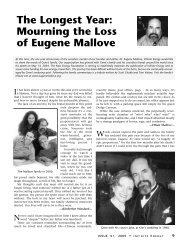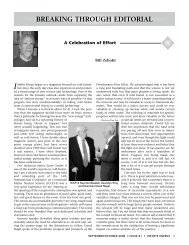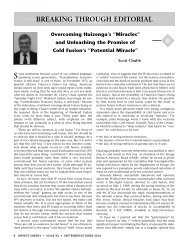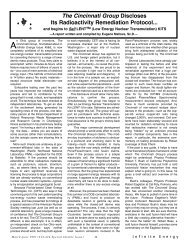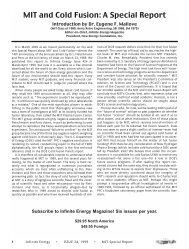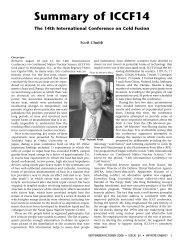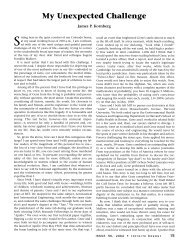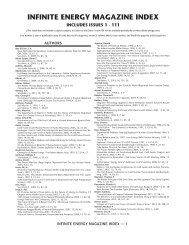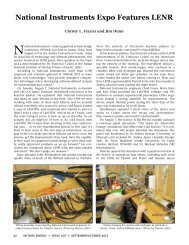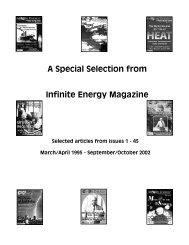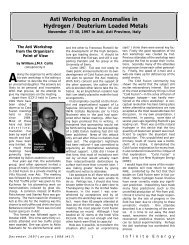Martin Fleischmann's Historic Impact - Infinite Energy Magazine
Martin Fleischmann's Historic Impact - Infinite Energy Magazine
Martin Fleischmann's Historic Impact - Infinite Energy Magazine
You also want an ePaper? Increase the reach of your titles
YUMPU automatically turns print PDFs into web optimized ePapers that Google loves.
As for LENR, <strong>Martin</strong> Fleischmann and my colleague, Stan<br />
Szpak (another renowned electrochemist), knew one another.<br />
Stan knew of the experiments <strong>Martin</strong> and Stan Pons were<br />
doing with palladium and heavy water and knew about the<br />
long incubation times. To overcome the incubation issues,<br />
he developed Pd/D co-deposition that in turn led to an<br />
amazing 23 year odyssey of discovery and exploration. It<br />
wasn’t always a smooth ride, but it was one we would not<br />
have undertaken if we didn’t have confidence in <strong>Martin</strong>’s<br />
findings.<br />
Dr. Mitchell Swartz and Gayle Verner<br />
(JET <strong>Energy</strong> and Cold Fusion Times)<br />
Intellectually honest and always approachable, Dr. <strong>Martin</strong><br />
Fleischmann is this century’s most unsung hero.<br />
His actions were those of a consummate seeker of the<br />
truth, as he was involved in two of the most important<br />
things in life: learning and teaching. He taught at King’s<br />
College, Durham University (later, University of Newcastleupon-Tyne)<br />
and the University of Southampton.<br />
<strong>Martin</strong> was a brilliant scientist and the co-inventor of cold<br />
fusion. He discovered, explored and taught the scientific<br />
fields of surface enhanced Raman scattering effect and the<br />
successful achievement of lattice assisted high energy production<br />
using nuclear reaction enabled by a palladium lattice,<br />
electrochemically loaded (cold fusion).<br />
In doing the earliest experiments and initial report, they<br />
created this new field in solid state nuclear physics which<br />
has not been like other scientific fields. The road to cold<br />
fusion has not been a smooth and easy path. At one point,<br />
experimentalists only had physical barriers to deal with, but<br />
<strong>Martin</strong> (and colleagues behind him) have had to deal with<br />
skeptics and third-rate thinkers who have sadly been in<br />
charge. Unnecessarily, they made life difficult for him and<br />
everyone else in the field that <strong>Martin</strong> had just created.<br />
The question was, or should have been: How can we make<br />
fusion work at lower temperatures? <strong>Martin</strong>, graced with<br />
determination and<br />
acumen, forged ahead<br />
as the leader in what<br />
will be the world’s<br />
never-ending quest to<br />
put cold fusion and<br />
clean energy produc-<br />
Photo courtesy of Mitch Swartz<br />
<strong>Martin</strong> Fleischmann and Mitchell Swartz<br />
at ICCF7 in Vancouver, Canada, 1998.<br />
tion on the map. His<br />
actions brushed aside<br />
the naysayers, burly<br />
bureaucrats and their<br />
stale comments.<br />
<strong>Martin</strong> attended<br />
the international conferences<br />
on cold<br />
fusion that followed<br />
his discovery, and<br />
paid close attention to its development. He had a welldeserved<br />
rock star status in his newly created field. His footprints<br />
were so deep that his questions and supportive comments<br />
were the things that kept us going through much travail<br />
that followed.<br />
Fortunately, <strong>Martin</strong> lived to see the beginning of the<br />
“phase change” of social awareness to cold fusion, but not<br />
11 INFINITE ENERGY • ISSUE 105 • SEPTEMBER/OCTOBER 2012<br />
yet its adoption or implementation.<br />
<strong>Martin</strong> (and his two partners) were the first to achieve the<br />
purposeful attainment of cold fusion (fusion of deuterons to<br />
helium-4) using applied electric fields and a lattice and salty<br />
heavy water. It was not the most efficient way to do cold<br />
fusion, but as the cat whisker junction is to the Internet, Dr.<br />
<strong>Martin</strong> Fleischmann’s contribution in cold fusion will be to<br />
enable space travel, fully powered artificial internal organs,<br />
and more.<br />
We will never forget his contributions, and will miss his<br />
clear, reasoned thinking. The world is slowly, but inexorably,<br />
moving toward a better place because of <strong>Martin</strong><br />
Fleischmann’s transit through it.<br />
Dr. Frank Gordon<br />
(Retired, Space and Naval Warfare Systems Center, SPAWAR)<br />
While we are all saddened now, I remember <strong>Martin</strong> for his<br />
smile, quick wit, genius and determination. It is a rare individual<br />
who can withstand the personal attacks that he<br />
endured and continue to smile and keep going. I’m sure that<br />
everyone who knew him has good memories from their<br />
friendship. He modestly recognized his contribution with<br />
this quote: “Scientists are really very conscious of the fact<br />
that they stand on the shoulders of an enormous tree of preceding<br />
workers and that their own contribution is not so<br />
enormous.” We are all standing on the shoulders of <strong>Martin</strong><br />
who, I’m sure with a smile on his face and a twinkle in his<br />
eye, added his own limb to the tree of knowledge. We can all<br />
honor his memory by continuing the research that he started<br />
until his limb becomes recognized for the revolutionary<br />
scientific breakthrough that it represents.<br />
Dr. Edmund Storms<br />
(Retired, Los Alamos National Laboratory)<br />
<strong>Martin</strong> demonstrated that Nature has a diabolical plan.<br />
He and Stan were not the first to cause the LENR process but<br />
they were the first to attract attention. For that they paid the<br />
price Nature always extracts when a great discovery is made.<br />
They attempted the “impossible” based on a flawed model,<br />
using lucky material that most people could not duplicate,<br />
and stirred up a firestorm of antagonism from people who<br />
were their colleagues and friends. They were rejected for reasons<br />
both ignorant and self-serving by people who we all<br />
thought should know better. Sadly, <strong>Martin</strong> did not live long<br />
enough to say he told them so, and have the last laugh.<br />
Hopefully, the rest of us can complete the process and gain<br />
acceptance for what he and Stan paid such a dear price to<br />
make known. We will all miss the man who led all of us into<br />
this crazy field.<br />
Lawrence Forsley<br />
(President, JWK International Corporation)<br />
I had the opportunity to meet <strong>Martin</strong> Fleischmann for the<br />
first time at ICCF7 in Vancouver, British Columbia, though<br />
I’d become familiar with cold fusion soon after the<br />
announcement in 1989. Nearly half my time since then has<br />
been spent pursuing cold fusion in a variety of labs with peo-



